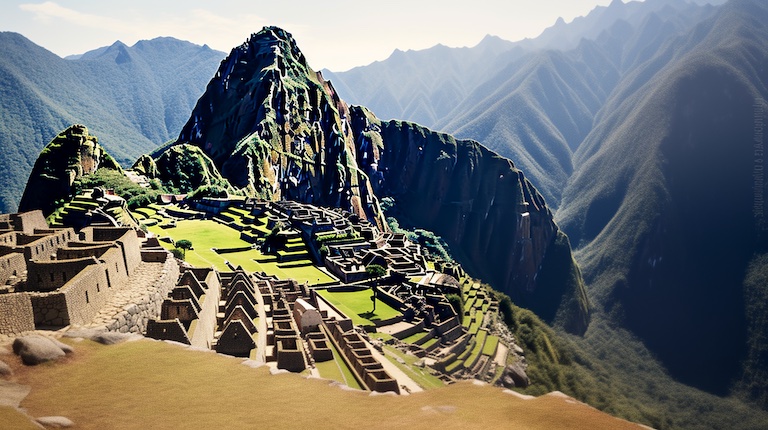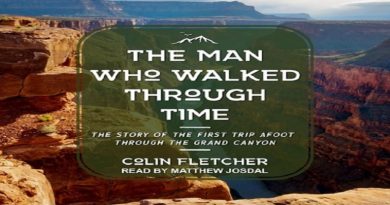“Turn Right at Machu Picchu: Rediscovering the Lost City One Step at a Time” by Mark Adams
In “Turn Right at Machu Picchu: Rediscovering the Lost City One Step at a Time,” Mark Adams takes readers on an exhilarating journey through the ancient ruins of Machu Picchu. This captivating book reveals Adams’ personal quest to unravel the mysteries surrounding this iconic city, as he retraces the footsteps of Hiram Bingham III, the American explorer who brought Machu Picchu to the world’s attention in 1911.
Adams immerses himself in Inca history and culture, embarking on a physically demanding trek through treacherous terrain. With every step, he unearths fascinating artifacts and uncovers untold stories that shed new light on this enigmatic civilization. Turning right where most visitors turn left, Adams ventures off the beaten path to encounter hidden temples, secret chambers, and breathtaking vistas that few have ever witnessed.
Overview of the book and its author
“Turn Right at Machu Picchu: Rediscovering the Lost City One Step at a Time” is an enthralling travelogue written by Mark Adams. The book takes readers on a captivating journey through the Peruvian Andes, chronicling Adams’ quest to unravel the mysteries of Machu Picchu. Drawing inspiration from Hiram Bingham III, who rediscovered the ancient Inca city in 1911, Adams embarks on his own adventure to experience and understand this remarkable archaeological site.
Adams, an experienced journalist and author with a knack for investigative reporting, brings his expertise to the forefront as he meticulously researches every aspect of Machu Picchu’s history. He blends historical facts with personal anecdotes, creating a narrative that is both informative and engaging. Through his vivid descriptions and witty storytelling style, Adams transports readers into the heart of Peru’s majestic landscape while unraveling the enigma surrounding this famous World Heritage Site.
With “Turn Right at Machu Picchu,” Mark Adams not only provides an overview of his thrilling adventure but also delves into the life and accomplishments of Hiram Bingham III. By exploring Bingham’s expeditions and discoveries in Peru, Adams offers valuable insights into the challenges faced by early explorers and sheds light on their contributions to our understanding of ancient civilizations. This well-researched book serves as a tribute to both Machu Picchu itself and those who have dedicated their lives to uncovering its secrets.
Background:
In his book “Turn Right at Machu Picchu: Rediscovering the Lost City One Step at a Time,” author Mark Adams takes readers on a captivating journey through the ancient ruins of Machu Picchu. Fueled by his fascination for this elusive city, Adams embarks on an adventure to retrace the steps of Hiram Bingham III, the Yale professor who discovered Machu Picchu in 1911.
Adams provides readers with historical context, delving into Bingham’s life and motivations for exploring Peru’s remote regions. The author highlights how Bingham’s search for Vilcabamba, the last Inca stronghold against Spanish conquistadors, ultimately led him to stumble upon Machu Picchu. By unraveling Bingham’s story and examining his controversial legacy, Adams sheds light on the complexities surrounding archaeological expeditions and cultural preservation.
As he recounts his own experiences navigating treacherous terrain and encountering indigenous communities along the way, Adams offers a fresh perspective on Machu Picchu. Through detailed descriptions and vivid imagery, he transports readers to this mystical place and immerses them in both its historical significance and natural beauty. This background sets the stage for an enthralling exploration of one of the world’s most iconic archaeological sites.
Brief history of Machu Picchu and its exploration
In his book “Turn Right at Machu Picchu: Rediscovering the Lost City One Step at a Time,” Mark Adams takes readers on a captivating journey through the history and exploration of Machu Picchu. The famous Incan citadel, nestled high in the Andes Mountains of Peru, has long been a source of fascination and mystery.
Adams delves into the origins of Machu Picchu, explaining that it was built around 1450 by the Inca emperor Pachacuti as a retreat for himself and his elite followers. However, just over 100 years later, it was abandoned and left to be reclaimed by nature. The existence of this hidden city remained unknown to outsiders until American explorer Hiram Bingham stumbled upon it in 1911.
Bingham’s discovery brought international attention to Machu Picchu, but questions about its purpose and significance still lingered. Over the years, archaeologists have unearthed more details about this enigmatic site, revealing its role as an important religious and ceremonial center for the Incas. Today, millions of visitors flock to experience its awe-inspiring beauty and immerse themselves in its rich history.
Journey to Peru:
In the book “Turn Right at Machu Picchu: Rediscovering the Lost City One Step at a Time” by Mark Adams, readers are taken on an enthralling journey through Peru. The author chronicles his own adventure as he sets out to follow in the footsteps of Hiram Bingham III, who famously rediscovered Machu Picchu in 1911. Throughout the narrative, Adams provides vivid descriptions of his experiences trekking through rugged terrains, encountering local communities, and uncovering fascinating historical artifacts.
Adams skillfully weaves together history and personal anecdotes to create a captivating account of his journey. His exploration of Peru goes beyond just visiting Machu Picchu; he delves into lesser-known archaeological sites such as Choquequirao and Vilcabamba, shedding light on their significance while narrating the challenges faced during these expeditions. Along with describing the physical aspects of his adventure, Adams also explores the rich cultural heritage of Peru, introducing readers to its diverse population and traditions.
As readers embark on this virtual journey to Peru through Mark Adams‘ eyes, they not only gain insights into the wonders of ancient civilizations but also develop a deeper appreciation for the modern-day country and its people. The book serves as both a travelogue and historical guide that inspires wanderlust while highlighting the importance of preserving our world’s cultural treasures.
Adams’ preparation for his adventure
In “Turn Right at Machu Picchu: Rediscovering the Lost City One Step at a Time,” the author, Mark Adams, recounts his journey to follow in the footsteps of Hiram Bingham III, who discovered Machu Picchu in 1911. Before embarking on this adventure, Adams thoroughly prepared himself both physically and mentally. He knew that traversing the rugged terrain of Peru would require stamina and endurance.
To get in shape for his expedition, Adams began an intense training regimen months before setting foot on Peruvian soil. He focused on building his cardiovascular endurance by incorporating daily hikes and long-distance runs into his routine. Additionally, he engaged in strength training exercises to strengthen his muscles for carrying a heavy backpack during the trek.
Mental preparation was equally important for Adams as he familiarized himself with the history and culture surrounding Machu Picchu. He delved into extensive research about Inca civilization, Bingham’s expedition, and other accounts of adventurers who had previously explored these ancient ruins. This background knowledge helped Adams gain a deeper appreciation for the significance of his upcoming journey while also equipping him with essential information about what to expect during his own exploration of Machu Picchu.
Rediscovering the Lost City:
In “Turn Right at Machu Picchu: Rediscovering the Lost City One Step at a Time,” author Mark Adams embarks on an adventurous journey to rediscover the ancient city of Machu Picchu. Inspired by the exploits of Hiram Bingham, who first brought Machu Picchu to global attention in 1911, Adams sets out to follow in his footsteps and unravel the mysteries surrounding this iconic site.
As Adams treks through rugged terrain and navigates dense jungles, he encounters fascinating characters who share their knowledge and stories about Machu Picchu. Along the way, he learns about its history as a sacred Incan city and its subsequent abandonment. Adams delves into the various theories surrounding Machu Picchu’s purpose – was it a fortress or a religious sanctuary?
Through vivid descriptions and engaging storytelling, “Turn Right at Machu Picchu” takes readers on an immersive exploration of one of the world’s most enigmatic archaeological sites. It offers not only historical insights but also personal reflections on adventure, discovery, and our innate curiosity about lost civilizations. Rediscovering the lost city becomes not just a physical journey but also an introspective one as Adams contemplates his own place within this rich tapestry of human history.
Highlights of Adams’ experiences at Machu Picchu
In his book “Turn Right at Machu Picchu: Rediscovering the Lost City One Step at a Time,” Mark Adams recounts his personal experiences and highlights during his journey to Machu Picchu. As he embarked on the Inca Trail, Adams was struck by the beauty and grandeur of the ancient ruins that lay ahead. The awe-inspiring landscapes, lush green valleys, and towering mountains formed a breathtaking backdrop for his exploration.
Adams vividly describes the moment he first laid eyes on Machu Picchu itself, capturing its mystical allure and sense of wonder. He delves into the history of this enigmatic city built by the Incas centuries ago, shedding light on its significance and mystery. From wandering through intricate stone structures to deciphering ancient Incan rituals etched in walls, Adams immerses readers in the atmosphere of this sacred site.
Moreover, Adams does not shy away from sharing personal anecdotes from his adventure at Machu Picchu. He recounts encounters with local Quechua people who graciously welcomed him into their communities, providing insight into their culture and way of life. Through these interactions, Adams gains a deeper appreciation for not only Machu Picchu but also for Peruvian heritage as a whole. His tales serve as an invitation to discover not just an archaeological marvel but a rich tapestry of history and humanity hidden within these iconic ruins.
Uncovering Secrets:
In “Turn Right at Machu Picchu: Rediscovering the Lost City One Step at a Time,” author Mark Adams takes readers on an adventurous journey through the mysterious ruins of Machu Picchu. This captivating book uncovers secrets and sheds light on the fascinating history and culture surrounding this ancient Incan city.
Adams shares his personal experiences as he retraces the steps of Hiram Bingham, who famously rediscovered Machu Picchu in 1911. Through vivid descriptions and engaging storytelling, he unveils hidden details about the site’s construction, purpose, and significance to the Inca civilization. From uncovering forgotten pathways to decoding sacred symbols, Adams delves deep into the mysteries of Machu Picchu and offers fresh insights into its enigmatic past.
Furthermore, “Turn Right at Machu Picchu” not only unravels historical secrets but also explores modern-day challenges surrounding this UNESCO World Heritage site. The book examines issues such as tourism impact on preservation efforts, cultural appropriation controversies, and ongoing scientific research that continues to reveal more about this iconic landmark. By peeling back layers of time and revealing untold stories, Mark Adams invites readers to join him on a remarkable quest for knowledge in “Turn Right at Machu Picchu.
Insights into the mysteries surrounding the ancient city
In “Turn Right at Machu Picchu: Rediscovering the Lost City One Step at a Time” by Mark Adams, readers are taken on a captivating journey into the mysteries surrounding the ancient city. With vivid descriptions and meticulous research, Adams provides fascinating insights into the enigmatic world of Machu Picchu. He delves into its history, exploring how this awe-inspiring citadel was built and what purpose it served for the Inca civilization.
One of the mysteries surrounding Machu Picchu is its purpose. While many theories exist, ranging from an agricultural center to a royal retreat, Adams examines these possibilities and presents his own interpretations based on his exploration of the site. Furthermore, he uncovers lesser-known aspects of Machu Picchu’s history, such as its abandonment by the Inca people and subsequent rediscovery by Hiram Bingham in 1911.
Adams also takes readers through his personal experiences as he retraces Bingham’s steps and explores hidden corners of Machu Picchu. From encounters with local guides to surviving treacherous terrains, he offers an intimate perspective that adds depth to our understanding of this ancient city. Through “Turn Right at Machu Picchu,” readers gain valuable insights into both the tangible wonders and intangible secrets that continue to shroud this extraordinary archaeological site.
Reflections and Lessons Learned:
“Turn Right at Machu Picchu: Rediscovering the Lost City One Step at a Time” by Mark Adams takes readers on an unforgettable journey through the stunning landscapes of Peru as he retraces Hiram Bingham’s legendary 1911 expedition to Machu Picchu. Throughout his adventure, Adams reflects on his own experiences and reveals valuable lessons learned along the way.
One of the most prominent reflections in “Turn Right at Machu Picchu” is the importance of embracing uncertainty. As Adams navigates treacherous terrains, encounters unexpected challenges, and grapples with limited resources, he learns to let go of control and appreciate the beauty in surrendering to the unknown. This lesson serves as a powerful reminder that life’s most rewarding moments often arise from taking risks and stepping outside one’s comfort zone.
Additionally, Adams highlights the significance of cultural preservation and respect for indigenous communities. Through interactions with local Quechuan people, who have long revered Machu Picchu as sacred grounds, he learns about their rich history and traditions. This deepens his appreciation for their culture while emphasizing how important it is to protect these heritage sites for future generations. Ultimately, “Turn Right at Machu Picchu” offers readers profound reflections on embracing uncertainty and honoring diverse cultures – lessons that resonate far beyond its pages.
Impressions and takeaways from Adams’ journey
In “Turn Right at Machu Picchu: Rediscovering the Lost City One Step at a Time” by Mark Adams, readers are taken on a thrilling adventure as they follow in the footsteps of Hiram Bingham III’s legendary expedition to Machu Picchu. Throughout his journey, Adams shares his impressions and takeaways, providing readers with a unique perspective on this iconic archaeological site.
One of the most significant takeaways from Adams’ journey is the immense significance of Machu Picchu in Inca history and its enduring allure for modern-day explorers. As he explores the ruins and delves into their intricate history, Adams paints a vivid picture of the extraordinary ingenuity and architectural brilliance that went into creating this lost city. His descriptions evoke a sense of wonder and awe, making it clear why Machu Picchu continues to captivate visitors from around the world.
Additionally, Adams’ journey highlights the challenges faced by those seeking to uncover ancient secrets. From navigating treacherous mountain trails to dealing with bureaucratic red tape, he exposes the difficulties inherent in exploring remote archaeological sites like Machu Picchu. Through his experiences, readers gain an appreciation for the dedication and determination required to unlock these historical mysteries while also realizing that there is much still left to discover about this enigmatic civilization.
Conclusion:
In conclusion, “Turn Right at Machu Picchu: Rediscovering the Lost City One Step at a Time” by Mark Adams offers readers an enthralling adventure through the ancient ruins of Machu Picchu. Through his engaging storytelling and meticulous research, Adams brings to life the journey of Hiram Bingham III, the American explorer who first revealed the hidden wonders of this Incan citadel to the world.
Throughout the book, Adams skillfully intertwines his own expedition with that of Bingham’s, creating a captivating narrative that keeps readers hooked until the very end. From navigating treacherous mountain trails to encountering local tribes and uncovering long-lost artifacts, Adams takes us on a thrilling ride through history and exploration.
Moreover, “Turn Right at Machu Picchu” not only presents an exciting travelogue but also sheds light on important societal issues surrounding archaeological preservation and tourism in Peru. By raising questions about responsible travel and cultural sensitivity, Adams prompts readers to reflect on their own impact as visitors in foreign lands.
Overall, “Turn Right at Machu Picchu” is a must-read for any adventurer or history enthusiast who seeks to explore one of the world’s greatest mysteries while delving into thought-provoking themes about our place in ancient civilizations and our responsibility towards preserving their legacy.
Final thoughts on “Turn Right at Machu Picchu”
In conclusion, “Turn Right at Machu Picchu” is a captivating adventure memoir that takes readers on a thrilling journey through the jungles of Peru. Mark Adams provides an insightful and humorous account of his quest to retrace the steps of Hiram Bingham III, the American explorer who discovered Machu Picchu in 1911. Through vivid descriptions and engaging storytelling, Adams brings the lost city to life, allowing readers to experience its beauty and mystery firsthand.
One of the standout aspects of this book is Adams’ ability to weave history seamlessly into his narrative. He delves deep into the historical context surrounding Machu Picchu, providing fascinating insights into Inca civilization and the significance of this ancient city. Additionally, Adams skillfully incorporates personal anecdotes and encounters with local guides and experts, adding depth and authenticity to his exploration.
Ultimately, “Turn Right at Machu Picchu” not only serves as a travelogue but also offers introspection on the allure of adventure itself. Adams reflects on the transformative power of stepping out of one’s comfort zone and embracing uncertainty. With its combination of history, adventure, and personal reflection, this book is sure to captivate both armchair travelers and those planning their own expedition to Machu Picchu.












